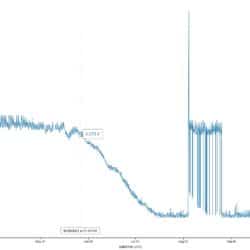Forum Replies Created
-
AuthorPosts
-
2021-09-28 at 5:55 PM in reply to: Mayfly not writing to SD card = possibly a libraries issue? #15936
Sara captures all the libs specified as part of the release procedure https://github.com/EnviroDIY/ModularSensors/releases/tag/v0.30.0 look for ModularSensors_Dependencies_v0.30.0.zip
I’ve not had any issue with 0.30.0.. The tests are heavily utilizing the SD for reliable web delivery, storing them to uSD, before a POST.
I do a build from scratch including pulling all the libs when I do a release.
https://github.com/neilh10/ModularSensors/releases/tag/v0.30.0.release1_210831Building 210831_1234
Dependency Graph|– <EnviroDIY_ModularSensors> 0.30.0+sha.bc3dd0e
| |– <EnableInterrupt> 1.1.0
| |– <SdFat> 2.0.7
| | |– <SPI> 1.0
| |– <TinyGSM> 0.11.4What’s the battery size (maHr) and solar panel (W)?. Also which port do you plug the solar panel into?
I’m wondering though, you are also sampling every 5minutes, do you need it to be that frequent? Would 15minutes work?
Interesting, it does seem to be a sudden V drop. Looking at the raw readings on the downloaded csv it is also oscillating from 4.1V to 3.6V a couple of times, which seems very unlikely in real life. Time snip at UST 2021-08-25 14:00
<table width=”344″>
<tbody>
<tr>
<td width=”140″>time</td>
<td width=”140″> time diff</td>
<td width=”64″>V</td>
</tr>
<tr>
<td>2021-08-25 14:00</td>
<td>0:05</td>
<td>4.094</td>
</tr>
<tr>
<td>2021-08-25 14:05</td>
<td>0:05</td>
<td>3.563</td>
</tr>
<tr>
<td>2021-08-25 14:10</td>
<td>0:05</td>
<td>4.094</td>
</tr>
<tr>
<td>2021-08-25 14:15</td>
<td>0:05</td>
<td>4.094</td>
</tr>
<tr>
<td>2021-08-25 14:20</td>
<td>0:05</td>
<td>3.563</td>
</tr>
<tr>
<td>2021-08-25 14:25</td>
<td>0:05</td>
<td>3.563</td>
</tr>
<tr>
<td>2021-08-25 14:30</td>
<td>0:05</td>
<td>4.154</td>
</tr>
<tr>
<td>2021-08-25 14:35</td>
<td>0:05</td>
<td>4.139</td>
</tr>
<tr>
<td>2021-08-25 14:40</td>
<td>0:05</td>
<td>3.563</td>
</tr>
<tr>
<td>2021-08-25 14:45</td>
<td>0:05</td>
<td>3.563</td>
</tr>
<tr>
<td>2021-08-25 14:50</td>
<td>0:05</td>
<td>3.563</td>
</tr>
</tbody>
</table>Just an observation, once the hardware is working nicely, it often takes more software to manage that hardware
– it’s a broad subject when talking about power – the battery voltage encodes battery type , solar panel sizing, solar aspect and vegetation coverage, and when is the power used – all to get the readings to show reliably on the web through all the seasons!!
I include a “sample number” or sequence number in my recording, so I can easily validate the data (missing sequences) and processor resetting. (sample number goes to zero) . A sample number might help show happens when the dates jump. Its ProcessorStats_SampleNumber() part of ProcessorStats()
I also found in early testing, I was getting resets at sunset (!) with small batteries, and standardized on using a 4.4Ahr battery. With a good solar aspect on a 2.5W solar panel, it charges in 8hours . Of course winter may not have that good a solar aspect, and typically has less sunshine unless its on the equator !! so I oversize the panel a little if I can, eg 3~5W
One thing for sure is that if the battery runs down completely, its a software issue on how it powers up and recharges the battery, one of the challenges in a remote solar powered logger. The “sample number” does help understand what is going on.
For my systems, it would take half a day to go and replace with a fully recharged battery (and who pays for all that time) – I upgraded the software to better manage the voltage. I also use “reliable delivery” of readings to the web, so when the voltage is low ( I use 3.8V on 4.4Ahr) the rest of the power is reserved for just reading the instruments. This can keep it working during a two week storm with no solar. Then when the sun comes out (and the solar panel hasn’t blow over) the battery charges back up, and it transmits all the stored readings. The software is on my fork, (which anybody is welcome to use) and or could be migrated back into the main.
Also seems to me the core issue is you lost charging /solar about the end of May.
Possibly the panels got over grown, or shaded out.
I have a separate LiIon charger ~ https://www.adafruit.com/product/1905 – but a spare mayfly also works.
Attachments:
Good to hear that the gauges survived, and delivered the data.!!
Many thanks for the refresh on status and (target) date :). Very helpful.
Just wondering any visibility on a timeline for new Mayfly, and what the new goodies are :).
I am looking at recommending it in an SSU Engineering project.
The first projection on availability was early August, just wondering if there is anything that can be shared about the difficulties in them becoming available. I know some of these issues are challenging, and I appreciate tested boards, visibility really helps in planning projects and alternatives. Many thanks.
2021-09-18 at 9:48 PM in reply to: Mayfly not writing to SD card = possibly a libraries issue? #15905An idea, equipment failure isolation. (assuming you’ve got the board in a lab location) Possible combinations of the three variable 1) switch uSD and 2) switch Mayfly 3) add separate USB power supply via USB cable. Does the Mayfly always fail writing to the uSD, even with known working uSD. That could be that the uSD slot has a failure (effectively Mayfly bad). I get a white/red SD card so that I give each SD card a number on the white portion so I can track them.
@zeke-holloman great glad to hear it.
Which modem did you buy and where did you get it?. I thought they were in short supply, and I’ve been keeping my eye open for them.
I’ve been using the Digi LTE XB3-C-A2-UT-001, which needs the the latest XCTU modem board to upgrade as its is a complex process.
I’m using Release 0.30.0 for stability regression testing, its gone well, and captured a visual description of it here 0.30.0 testing
Hello @d_bozza123, the Ponsel sensor looks very interesting.
I’ve interfaced to a SDI-12 sensor Insitu LT500.
My suggestion is you think of breaking up the work into units.
That is first how to read the sensor Ponsel, and 2nd how to store it to the .csv
For my sensors, it required creating a sensor interface to read the parameters from the instrument.
eg https://github.com/EnviroDIY/ModularSensors/blob/master/src/sensors/InSituRDO.h
or similarly in my case https://github.com/neilh10/ModularSensors/blob/release1/src/sensors/InsituTrollSdi12.h
Then in the program file eg “simple_logging.ino” create the sensors
See Variable* variableList[] = in https://github.com/EnviroDIY/ModularSensors/blob/master/examples/simple_logging/simple_logging.ino
To think of LoRa is a great idea, and a number of people are thinking about it. So just curious where it would visualize the data on the internet?.
A smaller step would be to post to MonitorMyWatershed.org over a cellular modem LTE to learn about the flow of data?
One of the issues with LoRa might be how is wall time synced to the mayfly?
-
AuthorPosts

 Welcome to EnviroDIY, a community for do-it-yourself environmental science and monitoring. EnviroDIY is part of
Welcome to EnviroDIY, a community for do-it-yourself environmental science and monitoring. EnviroDIY is part of 